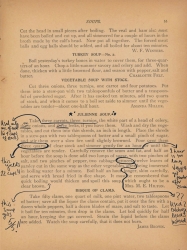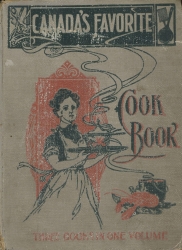
 604 465 4322
604 465 4322General Store Site 12294 Harris Road Pitt Meadows, B.C.
Click Here for Directions& Visiting Hours

Julienne Soup 1907
Recipe
Take three carrots, three turnips, the white part of a head of celery, three onions and three leeks if you have them (We used only one of each with 4 cups of stock). Wash and dry the vegetables, and cut them into thin shreds, an inch in length. Place the shreds in a stew-pan with two tablespoons of butter and a small pinch of sugar, and stir them over a slow fire until slightly browned. Pour over them three quarts of clear stock (this yields 12 cups!!) and simmer gently for an hour (one hour is too long, veggies get tender after 20 minutes) or until the vegetables are tender. Carefully remove the scum and fat, and half an hour before the soup is done add two lumps of sugar, with two pinches of salt, and two pinches of pepper, two cabbage lettuces (used 2 cabbage leaves instead), twelve leaves of parsley cut in the same way as the other vegetables, after being immersed in boiling water for a minute. Boil half an hour longer, skim carefully, and serve with bread fried in dice shape. It must be remembered that quick boiling would thicken and spoil this soup, which out to be a clear brown. Mrs. M.E. Hilton. (This soup gets 5/5!)
*****
As children, our parents often would make us a cup of hot chicken noodle soup to ease our sore throats and fill our troubled tummies. We knew the magic contained in that hot broth and felt safe knowing our parents cared for us. Whenever we are sick, childhood memories come flooding in. The heavy blanket, the warm words, the smell of fresh soup, and the sound of the television in the background evoke a memory of comfort, and soup, means comfort. This recipe by Mrs. M.E. Hilton from Canada’s Favourite Cookbook was chosen because it presents itself as the ultimate comfort soup. With a simple broth as its base, textured with root vegetables cut into perfect little matchsticks, sweetened with onions and leeks, and flavoured with fresh parsley, this soup proved to be quite tasty and fulfilling.
Soup has not always been available at restaurants, cafes, or grocery stores, but it has always been a staple food. Soup dates back to ancient civilizations such as the Egyptians, Chinese, and Greeks, which used grains and meats to make a hearty soup. In Medieval Europe, peasants would use any ingredient available, usually scraps and leftovers. As time went on, soups became more sophisticated due to the demand from the upper classes, but the unavailability of certain ingredients was a problem poor communities couldn’t keep up with. A lack of ingredients would eventually lead to the creation of French onion soup, minestrone, and gazpacho. In Canada, soup’s history dates back thousands of years to the First Nations people. Using ingredients like wild game, fish, herbs, and vegetables allowed First Nations people to live off the land to create nourishing and filling foods. The European settler’s arrival to Canada brought their own soup traditions. French Canadians had their pea soup and English Canadians with traditional beef or chicken soup with noodles or dumplings. Fast forward a few centuries, canned soup was well received in every 20th-century household, with Campbell’s and Lipton leading the market. Towards the end of WWII, canned goods were in high demand, not only to send to troops but to add a level of convenience to women that had entered the workforce.
Pitt Meadows in 1907 looked much different than the city we know today. Since Pitt Meadows only became a district in 1914, there is a lack of records about life and people during this time. What we do know, from the minimal information available in the Pitt Meadows Museum records, is that Pitt Meadows ceded from Maple Ridge in 1896, becoming an unincorporated territory. By 1901 the population was less than 100. During this time, goods were brought into Pitt Meadows by ferries and boats until CPR built a train route in 1885. While getting food into Pitt Meadows was made more accessible, it was still expensive to order foods unavailable locally, such as bananas and oranges. Pitt Meadows would only obtain food through what farmlands could cultivate and produce, but also by local dairy and meat farms. Refrigerators were not a common household item until the post-WWII period. Before this, most Canadians used iceboxes, insulated cabinets cooled by ice blocks. Alternative food storing methods were pickling, salting, curing, or smoking meat, and canning. Pitt Meadows wouldn’t see any further advancements until 1908 and 1909, when the first post office and school were established.
This Julienne Soup recipe created in 1907 had intentions to be just another shared recipe in yet another cookbook available across Canada. And although we don’t personally know Mrs. M.E. Hilton, we can only imagine why she created this soup. It could be because she had a family and sick children to nurse back to health, or maybe it was because those ingredients were the only ones available in her root cellar in the dead of winter. Whatever the reason, Mrs. Hilton deserves our praise for this delicious and nourishing soup she created. Because of her, we can share this recipe with the public and pass it on to future generations as a warm and comforting reminder of the past.

Recipe for 1907 Julienne Soup

Julienne Soup 1907

Canada's Favorite Cookbook 1907





